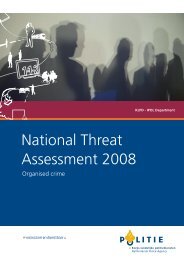Assessing the Effectiveness of Organized Crime Control Strategies ...
Assessing the Effectiveness of Organized Crime Control Strategies ...
Assessing the Effectiveness of Organized Crime Control Strategies ...
Create successful ePaper yourself
Turn your PDF publications into a flip-book with our unique Google optimized e-Paper software.
Jacobs and Gouldin (1999:176) are unequivocal about <strong>the</strong> achievements <strong>of</strong> this regulatory<br />
initiative in wresting control from OC in an industry that had been so tainted:<br />
The TWC has been remarkably successful. By driving corrupt firms from <strong>the</strong><br />
industry and simultaneously protecting customers from exploitation, new companies<br />
(with no ties to organized crime) have entered <strong>the</strong> industry…For <strong>the</strong> first time in<br />
history, national waste-hauling companies have entered <strong>the</strong> New York City market.<br />
In addition, waste-hauling rates have fallen dramatically (recent estimates claim<br />
decreases <strong>of</strong> 30-40 percent in <strong>the</strong> past two years)…Thus New York’s Cosa Nostra<br />
crime families have to contend with <strong>the</strong> loss <strong>of</strong> a significant revenue source and<br />
power base.<br />
Ano<strong>the</strong>r way <strong>of</strong> undercutting OC-dominated cartels, bid-rigging, and o<strong>the</strong>r anticompetitive<br />
practices is to establish public benefit corporations that disrupt illegal agreements by competing<br />
against those engaging in <strong>the</strong>m (Goldstock,1994:436).<br />
Whe<strong>the</strong>r <strong>the</strong> approach used is that <strong>of</strong> more regulation or <strong>the</strong> creation <strong>of</strong> public benefit<br />
corporations, <strong>the</strong> issue that remains to be answered by evaluators is whe<strong>the</strong>r <strong>the</strong> disruption <strong>of</strong><br />
such cartels in an industry occasions a net loss for OC or whe<strong>the</strong>r crime syndicates re-emerge in<br />
o<strong>the</strong>r areas or industries. While <strong>the</strong> above-mentioned examples <strong>of</strong> increasing regulation show<br />
considerable promise, comprehensive evaluations must consider <strong>the</strong> potential adverse affects <strong>of</strong><br />
additional regulation on an industry.<br />
4.18 Legalization or Decriminalization <strong>of</strong> Certain Goods and Services<br />
Ra<strong>the</strong>r than increasing regulation, <strong>the</strong> decriminalization <strong>of</strong> some goods and services provided by<br />
criminal networks might lessen <strong>the</strong> social demand that fuels OC. Products and services that are<br />
decriminalized may never<strong>the</strong>less be subject to regulation (Kenney and Finckenauer, 1995: 197).<br />
For example, a number <strong>of</strong> arguments have been made for <strong>the</strong> decriminalization <strong>of</strong> <strong>the</strong> possession<br />
<strong>of</strong> various psychotropic drugs. The substantial expenditures associated with drug enforcement<br />
could be allocated elsewhere (e.g., for treatment) and <strong>the</strong> medical as well as social ills (including<br />
crime) associated with <strong>the</strong> illicit status <strong>of</strong> heroin and o<strong>the</strong>r substances could potentially be<br />
minimized. Drug enforcement is not only costly; it has also been shown to be limited in its<br />
ability to curtail supply (Lyman and Potter, 1991:325).<br />
Also, it has been argued that <strong>the</strong> current approach drives up drug prices, <strong>the</strong>reby subsidizing<br />
ra<strong>the</strong>r than combating drug traffickers (Dennis, 1990). Prohibition in <strong>the</strong> US during <strong>the</strong> 1920s<br />
and 1930s transformed OC from small peddlers <strong>of</strong> vice into powerful crime syndicates with<br />
political connections, respectability that came from serving <strong>the</strong> public <strong>the</strong> alcohol <strong>the</strong>y desired,<br />
and <strong>the</strong> organization to deliver contraband to large numbers <strong>of</strong> people (Lyman and Potter,<br />
1991:323). Without <strong>the</strong> lucrative pr<strong>of</strong>its from drugs, criminal organizations might no longer be<br />
viable, although some evidence suggests that <strong>the</strong>y might shift to o<strong>the</strong>r activities. In Colombia,<br />
for example, pressure against <strong>the</strong> drug cartels led some <strong>of</strong> <strong>the</strong>ir henchman to take up kidnapping<br />
for a living, <strong>the</strong>reby dramatically increasing <strong>the</strong> incidence <strong>of</strong> this crime (Abadinsky, 1994:512).<br />
Also, legalization in one country would have no bearing on <strong>the</strong> demand for illicit substances in<br />
Research and Statistics Division / Department <strong>of</strong> Justice Canada | 53








